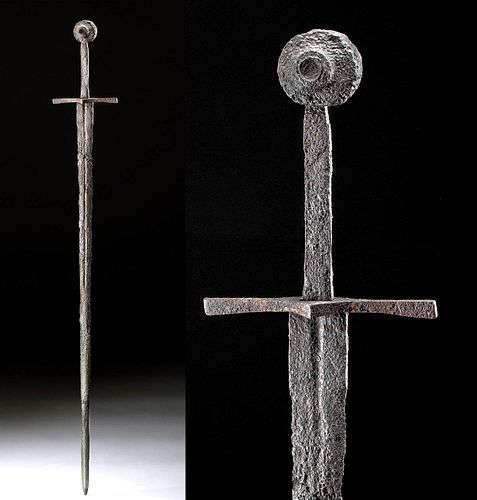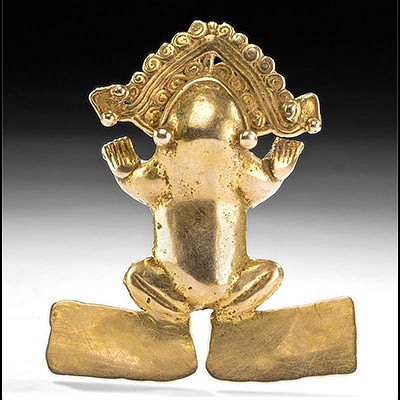Medieval Italian Iron Oakeshott Type XVI.2 Long Sword
Lot 43c
About Seller
Artemis Gallery
686 S Taylor Ave, Ste 106
Louisville, CO 80027
United States
Selling antiquities, ancient and ethnographic art online since 1993, Artemis Gallery specializes in Classical Antiquities (Egyptian, Greek, Roman, Near Eastern), Asian, Pre-Columbian, African / Tribal / Oceanographic art. Our extensive inventory includes pottery, stone, metal, wood, glass and textil...Read more
Categories
Estimate:
$8,000 - $12,000
Absentee vs Live bid
Two ways to bid:
- Leave a max absentee bid and the platform will bid on your behalf up to your maximum bid during the live auction.
- Bid live during the auction and your bids will be submitted real-time to the auctioneer.
Bid Increments
| Price | Bid Increment |
|---|---|
| $0 | $25 |
| $300 | $50 |
| $1,000 | $100 |
| $2,000 | $250 |
| $5,000 | $500 |
| $10,000 | $1,000 |
| $20,000 | $2,500 |
| $50,000 | $5,000 |
| $100,000 | $10,000 |
| $200,000 | $20,000 |
About Auction
By Artemis Gallery
Aug 13, 2020
Set Reminder
2020-08-13 10:00:00
2020-08-13 10:00:00
America/New_York
Bidsquare
Bidsquare : Fine Antiquities, Ethnographic & Fine Art
https://www.bidsquare.com/auctions/artemis-gallery/fine-antiquities-ethnographic-fine-art-5415
Features classical antiquities, ancient and ethnographic art from cultures encompassing the globe. Egyptian, Greek, Roman, Etruscan, Near Eastern, Asian, Pre-Columbian, Native American, African / Tribal, Oceanic, Spanish Colonial, Russian, Fine Art, so much more! Artemis Gallery info@artemisgallery.com
Features classical antiquities, ancient and ethnographic art from cultures encompassing the globe. Egyptian, Greek, Roman, Etruscan, Near Eastern, Asian, Pre-Columbian, Native American, African / Tribal, Oceanic, Spanish Colonial, Russian, Fine Art, so much more! Artemis Gallery info@artemisgallery.com
- Lot Description
Medieval Western Europe, Italy, ca. 1300 to 1325 CE. A stunning, forged-iron long sword of the Oakeshott Type XVI.2 with a slender hand guard and a discoid pommel. The cross style 2 guard has a slight central protrusion on either side and moves freely along the hilt, and the style K pommel features a petite recess along either side within the chamfered peripheries. The narrow triangular blade is complete with a deep fuller that traverses almost halfway down from the tang base as well as sharpened edges that taper downwards to form the acutely pointed tip. Warm, lustrous brown patina has formed across the blade, guard, hilt, and pommel and imbues the sword with a wonderful presentation. Size: 5.9" W x 40.1" H (15 cm x 101.9 cm); (blade): 33.4" L (84.8 cm)
The included academic report from military specialist Dr. Raffaele D'Amato reads: "Most probably our specimen was excavated from a battlefield or, most probably, from a river find. Very good though there are traces of corrosion all around the blade. The guard in style 2 was more elaborate than style 1. The central portion is strong and solidly rectangular; the arms are waisted and expanded at the ends. The section is most often square, but when it is, the edges are rounded off, but the ecusson is nearly always sharply squared off. Sometimes the section of the arms is circular, sometimes octagonal, but in these cases the ecusson remains rectangular. In rare cases the ecusson may be decorated with a small appendage protruding over the blade (Oakeshott,1964 (1994) p.114). Here the metal of the cross is very stout, of square section: the process of forging a carefully shaped bar of iron with a slot in the middle was not so simple and sometimes, like in the D'Acre sword, problems could very easily occur. The pommel is a very wide and flat variety of the type J. Rare before c. 1260, fairly common (particularly in art) between c. 1290-1350, and rare after that until c. 1480 (Oakeshott, 1964 (1994) plates 19B and 28A; fig. 28), often of oval shape (Oakeshott, 1964 (1994) plates 29 and 47). The most striking thing about these blades is that they seem very clearly to be made to serve the dual purpose of cutting and thrusting. The upper part of the blade was in the old style, but the lower part was acute enough, and stiff enough to thrust effectively. Thus it may have been equally useful against the armour prevalent in the first half of the 14th century--mail, mixed mail and plate (or "splinted armour"), or complete plate. Froissart describes two episodes in which the point was so acute to penetrate a plate armour: writing about an incident during the pursuit after the battle of Poitiers (1356 AD) he says: 'When the Lord of Berkeley had followed for some time, John de Hellenes turned about, put his sword under his arm in the manner of a lance, and thus advanced upon his adversary who, taking his sword by the handle, flourished it, and lifted up his arm to strike the squire as he passed. John de Hellenes, seeing the intended stroke, avoided it, but did not miss his own. For as they passed each other, by a blow on the arm he made Lord Berkeley's sword fall to the ground. When the knight found that he had lost his sword, and that the squire retained his own, he dismounted and made for the place where his sword lays. But before he could get there the squire gave him a violent thrust, which passed through both of his thighs so that he fell to the ground.' At the same time there was enough width and edge at the 'centre of percussion' or 'optimal striking point' to enable the blade to strike a very powerful shearing blow. These swords were therefore designed and intended to cut through mail and pierce plate. We may reasonably date the type to the period when all the kinds of armour, previously mentioned, were in use together, so at the beginning of 14th century AD, a period in which, in Italy, together with the early plate armours, great use of the very hard to penetrate protections in cuir bouilli, widely visible on the graves of the Angevine knights in South Italy and in the over mentioned paintings of San Gimignano."
See Oakeshott, E. "The Sword in the Age of the Chivalry." Woodbridge, 1964 (1994); Duffy, A.R. "European Swords and Daggers at the Tower of London." London, 1974; Oakeshott, E. "Records of the Medieval Sword." Woodbridge, 1991; similar to a specimen preserved in the Tower Armoury (Dufty, 1974, pl. 4a); other very similar specimen (maybe the most similar) is the sword in the Royal Armouries (inv. IX.1083), formerly d'Acre Edwards (Oakeshott, 1991, p. 149).
Provenance: private Fort Collins, Colorado, USA collection, acquired in London, England, UK; ex-TimeLine Auctions, London, England, UK; ex-private family collection of arms and armour, acquired on the European art market in the 1980s; accompanied by an academic report by military specialist Dr. Raffaele D'Amato
All items legal to buy/sell under U.S. Statute covering cultural patrimony Code 2600, CHAPTER 14, and are guaranteed to be as described or your money back.
A Certificate of Authenticity will accompany all winning bids.
We ship worldwide and handle all shipping in-house for your convenience.
#157265Blade repaired from three large pieces, with professional restoration along break lines. Nicks to blade edges commensurate with combat, with light pitting and nicks to blade, guard, hilt, and pommel, and minor encrustations. Wonderful patina throughout.Condition
- Shipping Info
-
All shipping is handled in-house for your convenience. Your invoice from Artemis Gallery will include shipping calculation instructions. If in doubt, please inquire BEFORE bidding for estimated shipping costs for individual items.
-
- Buyer's Premium



 EUR
EUR CAD
CAD AUD
AUD GBP
GBP MXN
MXN HKD
HKD CNY
CNY MYR
MYR SEK
SEK SGD
SGD CHF
CHF THB
THB














